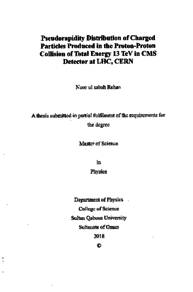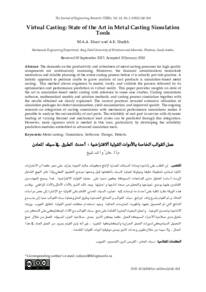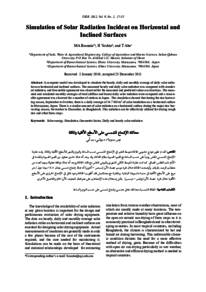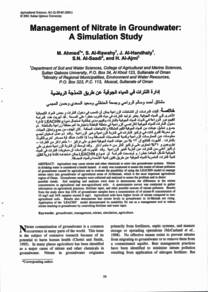وثيقة
Pseudorapidity distribution of charged particles produced in the proton-proton collision of total energy 13 TeV in CMS detector at LHC, CERN
الناشر
Sultan Qaboos University
ميلادي
2018
اللغة
الأنجليزية
الموضوع
الملخص الإنجليزي
The pseudorapidity distribution (dNch/dn) of the data sample acquired from the Compact Muon Solenoid (CMS) detector is an important measurement from the inner tracking system, the closest part of the detector system. The measurement is done by three different techniques generally and is compared to the Monte Carlo event generator simulations to tune the simulations as well as check the detector acceptance and performance. The method which is used in this research is called pixel cluster counting method which involves only the first barrel layer of the pixel detector encapsulating the beampipe, to count the clusters and analyse. This method is based on the correlation between the cluster length along the beamline (z-direction) and the pseudorapidity. Different processes of the event selection are from real-time online event selection to the offline event selection mainly established on the rejection of contaminations of the data such as the particles decaying after emerging from a collision or some products from the previous collision and many others. The pseudorapidity from the data analysis was consistent with the simulations as well as some previous results of similar data from the same run. The pseudorapidity distribution of a high energy collision is required as the first analysis step of the experimental results taken from any high energy collision experiment. This indicates the average number of particles produced in the collision, and further will be used for the transverse momentum distribution of the particles, which further leads to the understanding of fundamental science by these experiments. The pseudorapidity distribution has found to be a mean value of 5.77 by the pixel cluster counting method for the charged particles in the proton-proton collision at total energy Vs = 13 TeV
الوصف
Thesis
المجموعة
URL المصدر
الملخص العربي
التوزيع شبه التكراري ( dN / dn ) لعينة من البيانات المأخوذة من كاشف الCMS تعتبر ذا أهمية لأخذ القياسات للأجزاء الداخلية للكاشف التي تستخدم لتتبع أثر الجسيمات الدقيقة. هناك ثلاث طرق متبعة لأخذ القياسات وكلها تقارن فيما بعد بالحسابات العشوائية (Monte Carlo) لمولدات الجسيمات باستخدام المحاكاة الحسابية. هذه المقارنة تستخدم لضبط المحاكاة ضبطا دقيقا ولاختبار عمل الكاشف. الطريقة المستخدمة في هذا البحث تسمی تعداد البكسل العنقودي (pixel cluster counting) والتي تصلح للطبقة الأولى في الكاشف والتي تحيط بأنبوب حزمة البروتونات المستخدمة بالتصادم الطريقة تربط بين الطول العنقودي على طول الأنبوب -z) (direction والتوزيع شبه التكراري. اختيار عينات من البيانات في حالة تشغيل التصادم بين حزمتي البروتون وإطفاء التصادم أدى إلى التعرف على البيانات غير المرغوبة وبالتالي حذفها. من هذه البيانات غير المرغوبة بيانات الجسيمات التي تتحلل بعد التصادم أو الباقية من التصادمات السابقة. التوزيع شيه التكراري وجد متوافقا مع نتائج المحاكاة ومع النتائج السابقة كذلك لحزمة التصادم نفسها.
قالب العنصر
الرسائل والأطروحات الجامعية




